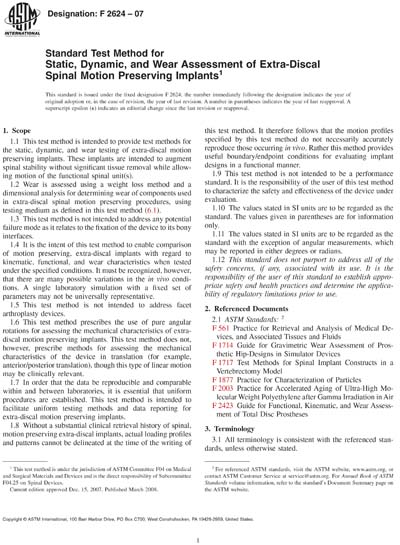Historical
ASTM F2624-07
Standard Test Method for Static, Dynamic, and Wear Assessment of Extra-Discal Spinal Motion Preserving Implants
1.1 This test method is intended to provide test methods for the static, dynamic, and wear testing of extra-discal motion preserving implants. These implants are intended to augment spinal stability without significant tissue removal while allowing motion of the functional spinal unit(s).
1.2 Wear is assessed using a weight loss method and a dimensional analysis for determining wear of components used in extra-discal spinal motion preserving procedures, using testing medium as defined in this test method (6.1).
1.3 This test method is not intended to address any potential failure mode as it relates to the fixation of the device to its bony interfaces.
1.4 It is the intent of this test method to enable comparison of motion preserving, extra-discal implants with regard to kinematic, functional, and wear characteristics when tested under the specified conditions. It must be recognized, however, that there are many possible variations in the in vivo conditions. A single laboratory simulation with a fixed set of parameters may not be universally representative.
1.5 This test method is not intended to address facet arthroplasty devices.
1.6 This test method prescribes the use of pure angular rotations for assessing the mechanical characteristics of extra-discal motion preserving implants. This test method does not, however, prescribe methods for assessing the mechanical characteristics of the device in translation (for example, anterior/posterior translation), though this type of linear motion may be clinically relevant.
1.7 In order that the data be reproducible and comparable within and between laboratories, it is essential that uniform procedures are established. This test method is intended to facilitate uniform testing methods and data reporting for extra-discal motion preserving implants.
1.8 Without a substantial clinical retrieval history of spinal, motion preserving extra-discal implants, actual loading profiles and patterns cannot be delineated at the time of the writing of this test method. It therefore follows that the motion profiles specified by this test method do not necessarily accurately reproduce those occurring in vivo. Rather this method provides useful boundary/endpoint conditions for evaluating implant designs in a functional manner.
1.9 This test method is not intended to be a performance standard. It is the responsibility of the user of this test method to characterize the safety and effectiveness of the device under evaluation.
1.10 The values stated in SI units are to be regarded as the standard. The values given in parentheses are for information only.
1.11 The values stated in SI units are to be regarded as the standard with the exception of angular measurements, which may be reported in either degrees or radians.
1.12 This standard does not purport to address all of the safety concerns, if any, associated with its use. It is the responsibility of the user of this standard to establish appropriate safety and health practices and determine the applicability of regulatory limitations prior to use.
ASTM International [astm]

